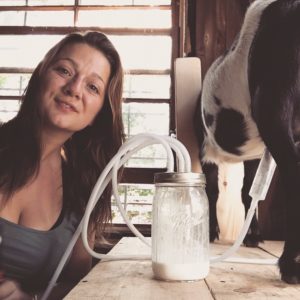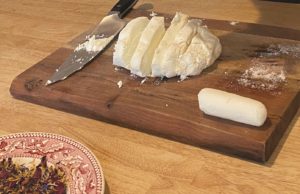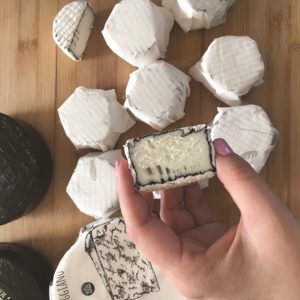Sadie Hill added two Nigerian dwarf dairy goats to her small farm in Brewster in 2015. Her plan was to show them in competitions and breed them to develop a line of good milking goats.
The names she gave those first two does — “Gouda Than You” and “Chatham Cheddar” — foreshadowed the sideline that became Hill’s passion. Now she’s more cheesemaker than farmer. She calls herself “a curd nerd.”

Hill was introduced to cheesemaking while traveling to grow her herd. “I would go up to Maine to pick up a new goat,” she says, “and find that many of the farms there had micro-dairies.” And when you’re breeding goats, you’re inevitably going to have milk on hand, Hills explains. “When my does were fresheners — which means that they were in milk after giving birth — it was only natural to give cheesemaking a try.”
She experimented first with ricotta — the fluffy fresh cheese traditionally made from whey, itself a byproduct of cheesemaking. A simple version can be made by heating whole milk with a small amount of acid in the form of vinegar or lemon juice.
Craving variety and complexity, Hill started traveling around New England to learn more. She would trade a day’s labor for a day of apprenticing with an artisanal cheesemaker. “Most cheesemakers,” Hill says, “are masters who make only one cheese.
“I’m a bit different,” she continues, “because I make so many different kinds.” The list of varieties Hill makes is long. It includes local versions of fresh cheeses like mozzarella, burrata, and chevre; runny-centered soft ripened rounds in the style of Camembert and Brie; aged cheeses in the tradition of Cheddar, Cheshire, or alpine Tomme; and renditions of blues like Gorgonzola and Roquefort.

As she developed confidence in her repertoire, Hill also learned that in Massachusetts it is not legal to sell your own homemade cheeses unless you have an elaborate seven-room specialized commercial cheesemaking facility. So, instead, she took to teaching. Hill is comfortable in that role — she used to teach middle school. Now grown-up learners come from across the Cape and beyond for the two- to three-hour classes Hill gives at her home-based Two Goats School of Cheesemaking.
Each class focuses on a particular cheese. Late last month, I joined a class on spring goat-milk cheeses. Now I’m not sure I’ll be able to stay away on April 30, when Hill is teaching a class on making raw-milk Cheddar — an aged cow’s-milk cheese.
Hill likes goats’ milk for fresh cheeses, but “it can get very ‘goaty’ tasting as it ages,” she admits. Cow’s milk, she says, lends itself to aged cheeses. It is also easier to find if you’re not raising your own goats.

Either way, good cheese requires good milk. Milk from pasture-raised animals that eat a variety of grasses and herbs will make much tastier cheese than what will result from store-bought milk, Hill says. Besides, most milk you’ll find in stores has been ultra-pasteurized, which means that it has been heated to a minimum of 280 degrees F for at least two seconds. The process kills virtually all bacteria in the milk and therefore extends its shelf life, but it also destroys enzymes that create bonds between proteins and allow milk to coagulate — which is essential to cheesemaking. Fortunately for would-be cheesemakers, traditionally pasteurized milk can be found locally in whole and health food stores.
Cheeses of all kinds start in the same way, we learn. First, a culture of lactic acid bacteria is stirred into the milk. This raises its acidity as these “good bacteria” consume lactose (milk sugar) and convert it into lactic acid. Because they also contribute to the cheeses’ flavor and texture, different bacteria cultures are used to make different cheeses.
Next, we add rennet, a substance that contains the enzyme rennin, which separates the milk’s solid particles from water, allowing curds to form. Rennet is harvested from the stomach lining of ruminants — calves, young goats, or lambs — or can also be made from plants such as artichokes and nettles. It can be found in health food stores or ordered online from specialized cheesemaking sites.

After we have added rennet to the pot of milk simmering on Hill’s stove, the class watches as it separates into curds and whey — which takes just a few minutes. We ladle the soft curds into a muslin-lined colander, tie up the ends of the muslin, and hang it to drain. Since the cheese will need about 12 hours to be ready to shape, Hill pulls another chevre from the fridge. This one is ready to be rolled into logs, pressed with dried edible flower petals or patted with a thin layer of ash, and wrapped to take home.
Long ago, ash was used to preserve curds left overnight, but the practice became a style. The ash used in cheesemaking is a fine food-grade powder made from burning grapevines or wood. It doesn’t impart flavor, but it neutralizes acidity during ripening.
Many cheeses need pressing, then turning and tending as they ripen. Soft bloom-ripened cheeses are flipped for 7 to 10 days. By contrast, an aged cheese like a Tomme, for example, must be flipped every day for 3 months, and a washed rind cheese such as a Gruyere is brined daily for 6 months or longer.
But the chevre our class is making is very low maintenance. It’s ready after a day and does well in the cold environment of an ordinary refrigerator, whereas some cheeses need the equivalent of a cave at perhaps 55 degrees F for ripening.
Fresh cheeses are meant to be eaten within a week or so, but the log I took home did not last that long. My daughters and I ate it up before Russell got home from work.
“Cheesemaking is something everyone should experience at least once in their life,” says Hill. Around here, it has become something of a lost art, she admits. But one cheese at a time, her students are finding it again.
